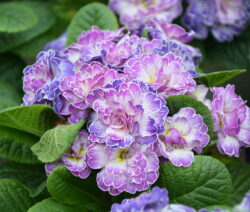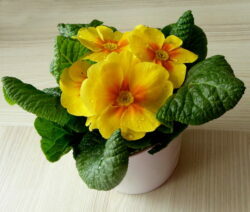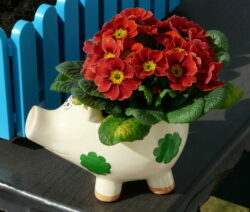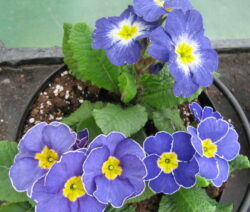Primroses are absolute heralds of spring. But what should you watch out for when planting and caring for the early and colorful spring blooming primrose?

Colorful primroses (Primula) in small pots are already part of the assortment of supermarkets and hardware stores in late winter. With low prices and a huge selection, the temptation is great to stock up for the new gardening season every year. The plants are only very rarely annual and only really feel good when they are planted out in the garden. If you keep a few things in mind when caring for it, the primrose family (Primulaceae) also very resistant to diseases and pests. So you can enjoy the colorful flowers for years.
contents
- Planting primroses: flowering time, planting time and location
- Combination with other plants
- Primrose as a houseplant
-
Buy primroses or propagate them yourself
- Buy primroses
- Primroses: harvest and sow the seeds
- Propagate primroses by dividing
- Maintain and water primroses
- Perennial primroses overwinter
Planting primroses: flowering time, planting time and location
The botanical name Primula means "the first" - very suitable for an early bloomer, in which some species begin to bloom as early as January. There are 500 in total Primrose specieswhich are in bloom from February to May. Bunk Primroses (Primula bulleyana and Primula bullesiana-Hybrids) even bloom from June to July. The simple, double or ruffled flowers are rarely single. Usually 2 to 25 inflorescences stand together as umbels or whorls and shine depending on the species in lavender, magenta, pink to purple. More rarely you can find red and white to yellow flowers. So that you have friends with your primroses for years, you should take a few things into consideration when planting them.



- Planting time: spring or autumn
- Location: sun or partial shade; no direct sun
- Soil: loose, nutrient-rich (admixture of compost) garden soil, good water retention
- Soil pH: slightly acidic
This must be taken into account when planting primroses
The primrose is originally native to the entire northern hemisphere. The very perennial wild and garden shrub flowers once planted in the garden and again in the following year. With these step-by-step instructions, planting out will definitely work.
- The ground must not be frozen
- Planting hole: 20 cm deep; 20 cm in diameter
- Loosen up the soil and add compost
- Remove the primrose from the pot and open the root ring on the root ball
- Primrose goes into the planting hole and the root ball is covered with earth
If these conditions are observed, you can plant primroses outside in the garden or on the balcony as you like. Primroses look good in pots, beds, rock gardens or flower boxes. As early bloomers, they set the first color accents as underplanting of hedges, bushes and trees. Carpet primroses (Primula juliae) are beautiful ground covers. For slightly more humid locations, rose primroses are suitable (Primula rosea), because of their high tolerance to moisture.
Note: Most of the commercially available primroses were grown in the greenhouse. You are not used to cold temperatures. Therefore, it is best to acclimate the plants in a cool but sheltered place for a few days before transplanting.
Combination with other plants
Since primroses are in bloom from February to May, a combination with other early bloomers, such as daffodils (Narcissus), Snowdrops (Galanthus) or tulips (Tulipa). But also a combination with horned violets (Viola cornuta), Bellis (Bellis perennis) and spring daisies (Leucanthemum vulgare) is possible. These have a somewhat later flowering time, which overlaps with that of the primrose and allows your garden to shine in full bloom well into summer. In the bed, ferns, grasses or late-blooming perennials fill the gaps that appear after the primroses have bloomed.
Primrose as a houseplant
As a houseplant, for example, cup primroses (Primula obconica) Color in the dreary winter and ensure that spring fever spreads. You can even give expression to these spring feelings with a primrose. Because to give someone a primrose means: "Give me the key to your heart". If you want the primrose to feel comfortable in the room, however, there are a few things to consider.



- Location: bright and cool room (e.g. B. North window square)
- The cooler, the longer the flowering phase (around 15 ° C)
- Watering: lukewarm, low-lime water so that the root ball does not dry out; no waterlogging
- Fertilization: every 2 weeks during flowering
- Put outside in summer
- Bring inside before the first frost to overwinter
- Repotting: if necessary in early spring
Note: After flowering, the primroses can simply be planted out in the garden. Many species bloom a second time during the summer.
Buy primroses or propagate them yourself
Every spring, the shops lure with colorful little primrose pots. The little "good mood makers" do not necessarily have to be bought. If you already have older primroses at home or you harvested seeds last year, you can diligently grow new primroses yourself.
Buy primroses
From January primroses will be offered as small potted plants in supermarkets and hardware stores. After purchase, the primroses can be acclimatized for four to five days in the house before they are planted out. In perennial nurseries you will also find much more robust, small-flowered garden forms.



Primroses: harvest and sow the seeds
Primroses can be propagated well by sowing. This leads to a new combination of the parents. When combining different varieties, each seed resembles a colorfully filled surprise egg. If you want to be surprised, just stop looking at the withered inflorescences at the end of the season to clean up. The formation of the seed pods starts all by itself after fertilization. After that, do the following to harvest seeds:
- Cut off capsule fruits before they are really brown and dry
- Allow to ripen on a cloth and wipe off when the pods are dry, darkly colored, but still closed
- Seeds are ripe when they rattle inside the capsule
- Shake out the 10 to 100 brown seeds
- Store seeds in a screw-top jar in the refrigerator until sowing
Some species like pillow primroses (Primula acaulis) would also look like themselves. Here the capsule fruits simply remain on the plant. So that the independent propagation really works, the soil should be as loamy as possible. For everyone else, the following applies: The harvested or bought seeds are sown in spring between February and April so that the primroses bloom the following year. The seeds used should not be older than 10 months. Then the germination capacity is highest. Germination is sure to work if you follow a few things when sowing.
- February to April: sprinkle seeds on the sowing soil
- Sprinkle the seeds thinly with sand (light germinator!)
- Moisten the soil with a hand sprayer
- ideal germination temperature: 10 to 15 ° C (e.g. B. Balcony)
- transparent cover for humidity (air daily from germination)
- Germination time: 2 to 3 weeks
- Prick out into individual pots: 4-7 weeks after sowing
Note: Primroses are Cold germ. The seeds need a cold phase so that they can germinate better and more evenly. Therefore, a short frost during the germination period can even be beneficial.
Propagate primroses by dividing
The primrose has rhizomes that grow underground. These thickened shoot axes serve to store nutrients and to survive bad weather periods. But they can also be used to multiply through division. Only older plants with a diameter of 15 cm or more are suitable for division.
- Dig up the rhizome after flowering
- Remove the soil from the rootstock and divide it with a spade
- in min. Plant again at a distance of 20 cm
Note: Dividing the plants every 3 to 5 years promotes their longevity.
Maintain and water primroses
Primroses are undemanding comrades. They don't even need to be cut back. Nevertheless, there are a few little things to consider so that your flowers feel completely comfortable.
- Fertilization: spring when leaves sprout (organic fertilizer or compost)
- Watering: plenty of water during flowering; Soil moist but not wet; no waterlogging!
- Cleaning out faded inflorescences and dead plant parts
Primroses are sensitive to drought, but too much moisture increases the risk of gray mold (Botrytis) or root and stem rot.
Note: In young primroses, a lack of magnesium leads to yellowing of the leaves. Use 8 grams of magnesium sulfate (Epsom salt) dissolved in one liter of irrigation water.
Perennial primroses overwinter
Primroses are rarely annual. Most of the species are perennial shrubs or shrubs. They partially retreat into the ground in autumn and only some more sensitive varieties need light winter protection. Once planted, you don't have to do much to protect your darlings. If the temperatures stay below -5 ° C for longer, the primroses will get too cold. In the bed, simply cover your primroses with a nice layer of brushwood, leaves, moss, bark mulch or spruce branches. Pot primroses are best placed in a sheltered, cool place at 3 ° C to 10 ° C - for example in the stairwell or in the basement. More about the Overwintering of primroses and to avoid frost damage, can be found here.
